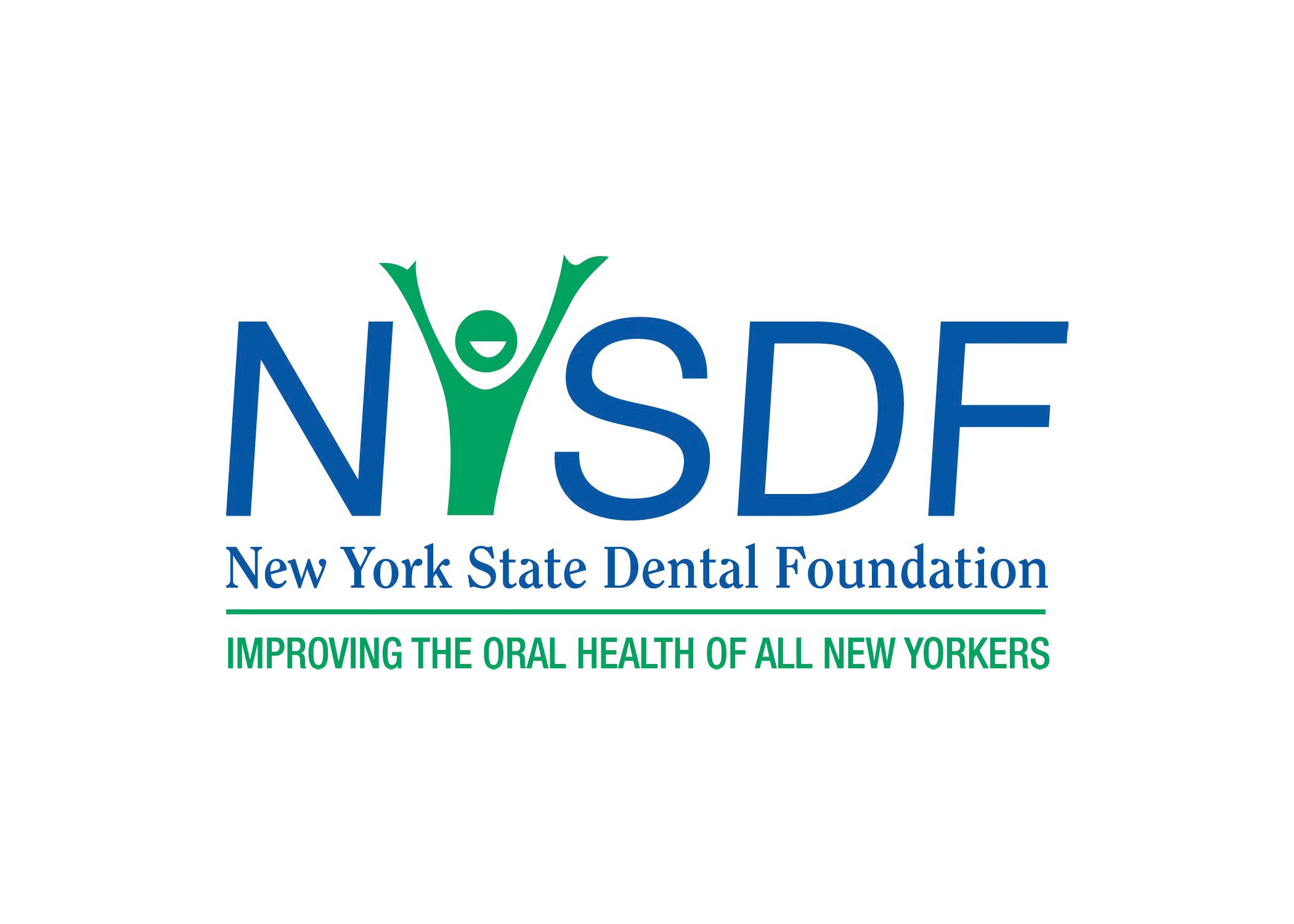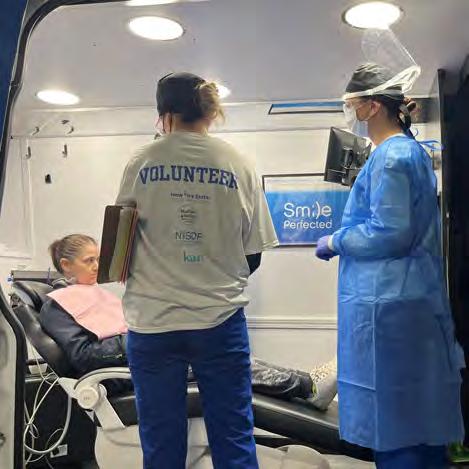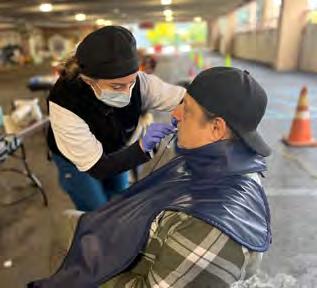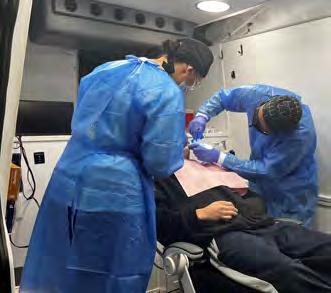
9 minute read
New York State Dental Foundation
When One Door Closes, Another Opens
NYSDA assembles team of volunteers to stage a day of dental care for displaced patients.
Stacy Mcllduff, CFRE
Thousands of patients have been displaced by the recent closure of two dental clinics in the Capital Region, leaving a significant void in oral healthcare services in the area, particularly for Medicaid patients. After the most recent closure, over 4,000 individuals received a letter notifying them that the dental doors they had long relied upon were closing, and, quite suddenly, they found themselves without a safety net for their dental needs.
Amidst this unsettling backdrop, two remaining health clinics emerged as lifelines for the displaced patients, but the strain on existing resourc es was—and still is—palpable. These clinics, already committed to serving their communities, now face a surge of calls and visits from patients desperate for a new dental home. A dentist at one clinic noted that they receive an astounding 40 to 50 calls daily, with most patients seeking urgent and emergency care. Other callers are tacked onto a daunting waiting list of over 3,500 patients.
This influx underscores the critical role dental professionals play in addressing not only routine oral health but also emergent situations that, when left unattended, can lead to more severe health complications.

A Day of Compassionate Oral Healthcare
In response to the urgency of the situation, the New York State Dental Association (NYSDA) spearheaded the “Capital Region Community Dental Event” on Oct. 21 in the heart of the Capital Region—forces rallying together to address a critical gap in dental care access. It was also an act of solidarity and a means of relieving pressure on people in crisis.
“In an effort to assist the patients who had been displaced, we thought we could work together to plan a service day,” said Greg Hill, NYSDA Executive Director. “We knew it would be a great way to help these patients in need of completing active treatment plans and assist them in connecting with dental health homes.”
It took a true team effort to bring together the professionals and resources necessary for a day dedicated to providing free dental care to those who needed it most. Hudson Valley Community College (HVCC) hosted the event on its Troy campus, and its dental hygiene and dental assisting students performed patient screenings in their clinic. With Dental Demonstration Project (DDP) grant funding from New York State, NYSDA contracted with Kare Mobile to have two dental vans on site. A team of five member dentists volunteered to perform care—some driving from as far away as Long Island and New York City to help. The New York State Dental Foundation provided logistical support and took care of students and volunteers.
It was a day for smiles at HVCC. More than 120 people had registered to receive dental screenings, emergent care, X-rays, treatment diagnosis, pain management guidance and extractions as needed. Others showed up without having an appointment. The atmosphere buzzed with compassion and a shared commitment to restoring smiles and promoting overall health.
First, HVCC’s dental hygiene and assisting students screened patients in the clinic. Then, patients who were identified as needing emergent care were referred to the Kare Mobile dental vans, where NYSDA volunteer dentists waited to perform extractions and other treatments. All told, more than 80 teeth were pulled from approximately 26 patients.
Role of Community Dental Health Coordinators
A significant highlight of the event was the pivotal role played by Marlyce James, a community dental health coordinator (CDHC), who worked with patients at the event and followed up afterward, becoming a bridge between the community and sustained oral health. CDHCs ensure that the impact of an event like this extends beyond a single day, connecting patients with follow-up care and, ultimately, dental homes.
The importance of post-event care coordination was underscored by the very last patient of the day, Jennifer Citrine, who waited for over two hours to be seen and almost didn’t make the cut.
“We had planned to hold the event until 4 p.m., but at that time there were still a few people waiting who needed care,” said Betsy Bray, NYSDA Director of Health Affairs. “We still had one dentist willing to treat them. We still had the vans. So, we decided to keep going as long as we could.”
Ms. Citrine, an Albany resident and single mother of two teenagers, learned about the event from her dentist. After visiting urgent care for severe jaw pain on Oct. 2, she was told she had an abscess and was prescribed antibiotics. She then followed up with her primary care physician, who treated her for strep throat and referred her to an ear, nose and throat specialist. But the ENT specialist told Ms. Citrine that her problem was dental.
Ms. Citrine’s story is a great example of how CDHCs, together with NYSDA dentists, can be the missing link in bringing oral healthcare to our most vulnerable populations.
“I had a sharp bone growing out of my jaw and through my gums. It felt like a baby’s teething pain, and then when the bone finally broke through, it was slicing my tongue,” said Ms. Citrine, who works as an administrative assistant for a realty company in Troy. She took four ibuprofen pills four times a day to cope with the excruciating pain of eating, talking and swallowing—the pain was so severe that it woke her up at night.
After being tossed around from one doctor to another for weeks, struggling to find someone who would take her Medicaid coverage to treat something that could be considered both medical and dental in nature, Ms. Citrine finally became desperate and snapped a piece of the bone off herself with a pair of tweezers.
“I was mostly worried about infection, but I sterilized the tweezers first,” she said. But then the pain continued, and it grew back, forcing her to remove another piece of bone on her own. “When you’re in pain, it just feels like you’re drowning. It feels like there’s no hope.”
At the Capital Region Community Dental Event, Ms. Citrine had an Xray taken, and her case was flagged as needing urgent attention. In the weeks that followed, Ms. James worked alongside Ms. Bray to find the dentist who could perform the 30-minute procedure necessary to relieve Ms. Citrine’s pain—a procedure that may not have happened for several more months if she did not have well-networked navigators advocating on her behalf.
Ms. Citrine’s story is a great example of how CDHCs, together with NYSDA dentists, can be the missing link in bringing oral healthcare to our most vulnerable populations.


Looking Forward
As the event concluded, the impact reverberated through the community and shed light on the pressing nature of this issue and emphasized the need for a swift and comprehensive response to ensure that patients like Jennifer Citrine are not left without the care they urgently require.
The Capital Region Community Dental Event marked the conclusion of NYSDA’s Dental Demonstration Project (DDP), a nine-year endeavor that showcased the effectiveness of community-based oral health initiatives. But as the DDP chapter closes, a new one begins.
The New York State Dental Foundation is launching a pilot program called “My Healthy Smile NY” on April 1, building on the successes of the DDP and bringing the CDHC model to scale statewide over the next four years.
“It’s so critically important that we ensure that the lessons learned, and the community connections forged during the DDP, continue to impact oral health throughout New York,” said Dr. Maria Maranga, chair of the Foundation Board of Trustees. “We want to pick right up where the DDP leaves off on March 31 and take a deeper dive into the efficacy of the CDHC model in expanding access to dental care.”
The pilot, which has been endorsed by the ADA and other groups, calls for a team of CDHCs to be deployed in strategic regions across the state, beginning with the North Country, Capital Region, Central New York and Long Island; in year four of the program, two additional CDHCs will be stationed in Western New York and the Metro New York area. Guided by a program director, the CDHCs will become an essential part of the patient navigation and community education system, poised to gather crucial data that can help inform policy and decisions that impact the health of all New Yorkers.
The CDHCs will also be actively engaged in promoting the dental professions in their regions, whether delivering oral health education to troops of young Girl Scouts, or visiting high school career fairs, introducing educational pathways to the dental professions will plant seeds to inspire diverse groups of young people to take good care of their teeth and to consider a career in oral health.
With state and private funding, the New York State Dental Foundation is hoping to offer more frequent dental events and oral cancer screenings across New York State, particularly in areas with great need. In late November, the Henry Schein Cares Foundation was the first external organization to commit to funding the pilot program with a grant of $40,000 over the next four years, in addition to providing in-kind support for event-related healthcare supplies. The Henry Schein Cares Foundation was established in 2008 by Henry Schein, Inc., to advocate and support efforts to advance health equity and empower healthcare professionals to promote a healthier tomorrow for all.
In the coming months, all eyes will be on the Foundation’s efforts to bring My Healthy Smile NY to life. It’s a journey marked by challenges, but it’s also a journey of compassion, unity and determination—a journey that reaffirms the commitment of healthcare providers to the communities they serve.
Ms. Mcllduff is executive director of the New York State Dental Foundation. Queries about My Healthy Smile NY and other Foundation programs can be sent to her at smcilduff@nysdental.org.










